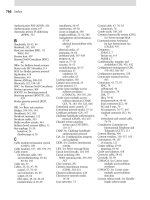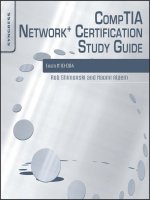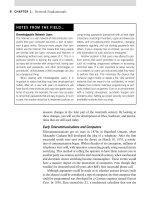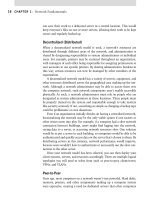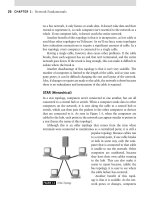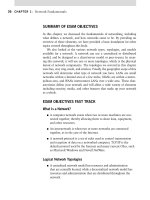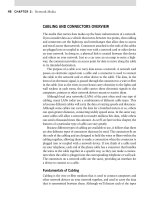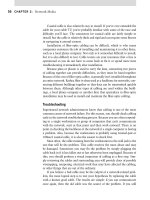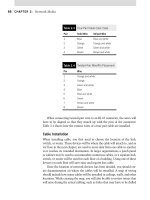CompTIA Network+ Certification Study Guide part 79 doc
Bạn đang xem bản rút gọn của tài liệu. Xem và tải ngay bản đầy đủ của tài liệu tại đây (99.12 KB, 11 trang )
Index
766
Authentication POP (APOP), 436
Authentication server, 197
Automatic private IP addressing
(APIPA), 323
B
Bandwidth, 50–52, 89
Baseband, 242, 583
Basic rate interface (BRI), 111
WAN, 362
Bastion host, 407
Bayonet-Neill-Concelman (BNC),
48
BBSs. See Bulletin board systems
Bearer code (BC) identifier, 114
BGP. See Border gateway protocol
Big Brother, 418
Biometrics, 441
Bitwise ANDing, 308–310
Bluetooth, 182, 190–191
BNC. See Bayonet-Neill-Concelman
Boolean operators, 308
BOOTP. See Bootstrap protocol
Bootstrap protocol (BOOTP), 326,
329
Border gateway protocol (BGP),
342
BRI. See Basic rate interface
Bridges, 104–105, 143
Broadband, 242, 583
Broadcast messages, 152
Broadcast traffic, 333
Buffer-overflow attacks, 444
Bulletin board systems (BBSs), 12
Bus topology, 25–26
benefit of, 26
disadvantage of, 26
C
Cable modem termination system
(CMTS), 109
Cable modems, 107, 109, 370–371
Cable testers
for Ethernet cable, 560
and troubleshooting, 58–62,
89–90, 559
Cable ties, 67
Cables, 33, 63, 87, 90
coaxial, 47, 78, 83
and connectors, 46, 89
copper, 63–64
fiber-optic, 48, 64, 84–85
fundamentals of, 46–48
installation, 66–67
interference, 49–50
issues in length of, 588
length problems, 52–54, 588
management and termination,
67–69
physical layer problem with,
587
physical media, 47
preparing, 64–66
problems with, 587–588
purpose of, 46
repair of, 57–58
security, 54–55
troubleshooting, 56–57
twisted-pair, 47
categories, 82
color codes, 65
Caching engines, 504
Campus area network, 35
Carrier protocol, 21
Carrier sense multiple access/
collision avoidance
(CSMA/CA), 184–185, 245
Carrier sense multiple access/
collision detection (CSMA/
CD), 70, 184–185, 245, 648
Centralized access control, 17
Centralized network model, 15–16
Certificate authority (CA), 457
Challenge handshake authentication
protocol (CHAP), 454–455
Channel service unit/data
service unit (CSU/DSU),
116–117
CHAP. See Challenge handshake
authentication protocol
CIA. See Confidentiality, integrity,
and availability
CIDR. See Classless interdomain
routing
CIFS. See Server message block
Circuit level firewalls, 129, 393
Circuit switching, 600
WAN operating with, 358–359,
363
Cisco systems, 391
Classless interdomain routing
(CIDR), 320–321
Cleartext authentication, 436
Client/server network model,
18–20
Coax networks, 73
Coaxial cable, 47, 78, 83
connectors, 76
Combo cards, 108, 263
Common Internet file system (CIFS).
See Server message block
Communications Assistance
for Law Enforcement Act
(CALEA), 491
Computers
ENIAC I, 7
history on, 6–8
MARK I, 7
Confidentiality, integrity, and
availability (CIA), 431, 432
Configuration management (CM),
478–493, 506–507
Configuration parameters, 328
Connection-oriented services,
605
Connectors, 45, 75, 91
BNC, 78
cabling and, 46
D connectors, 76
DIX, 77
fiber, 79–81
fundamentals of, 48–49
local connectors (LC), 80
RG and F-type, 79
RJ connectors, 76–77, 485
standard connector (SC), 48,
79
twisted-pair and coaxial cable,
76–79
Consultative Committee for
International Telephony and
Telegraph (CCITT), 111
Content filtering, 404
Content switches, 156–157, 163
Convergence, 99, 107
of security, 125
Copper cabling, 63–64
preparing, 64–66
Credit card adapters, 108
Crossover cable, 59–62
Crosstalk, 50, 89
CSMA/CA. See Carrier sense
multiple access/collision
avoidance
CSMA/CD. See Carrier sense
multiple access/collision
detection
Custom subnet mask. See Variable-
length subnet masks
Index 767
d
D-channel signaling protocol, 362
D connectors, 76
Data link layer, 183
MAC addressing of, 593
OSI model, 242–243
troubleshooting, 591–598, 623
contention methods for, 592
polling methods for, 592
recognizing devices of,
594–595
token passing methods for,
592
Data terminal equipment (DTE)
devices, 367
Data transmission rates, 368
Datagram, 604
Decimal to binary numbers,
converting, 295–299
Deep packet inspection firewall. See
Stateful inspection firewall
Default gateway, 137
Default subnet mask, 310–311
Defense Advanced Research Projects
Agency (DARPA) model. See
Department of defense (DoD)
model
Demarc, 69
Demilitarized zone (DMZ),
129–131, 406
bastion host, 407
design, 406–413
DNS services, 408–409
e-commerce, 409, 410
data storage zone, 410, 411
financial processing network,
411
e-mail relaying, 408
FTP services, 408
IDS in, 409
Internet Web site access, 408
layered implementation, 406
multiple interface firewall
implementation, 406, 407
Denial of service (DoS) attacks, 207,
210–211, 396, 429
protecting, 212
Department of defense (DoD)
model, 257–265, 277–278
advantages of, 576–577
application layer of, 264–265
host-to-host transport layer, 264
Internet layer, 263–264
mapping OSI model with, 259
network interface layer of
hardware/software, 262–263
MAC, 262
DHCP. See Dynamic host configura-
tion protocol; Dynamic host
control protocol
Dial-up modem speeds, 371–372
dig command, 555–556
syntax of, 555
Digital-Intel-Xerox (DIX), 72, 648
Digital signal zeros (DS0s), 361
Digital signaling
effects of attenuation on, 243
vs. analog signaling, 240–242
Digital subscriber line (DSL), 362,
368–369
asymmetric, 369
benefit of, 368
drawback of, 368
modems, 107
symmetric, 369
Direct sequence spread spectrum
(DSSS), 182–183
Directory access protocol (DAP),
448
Directory number (DN), 114, 115
Directory services, 447, 448. See
also Lightweight directory
access protocol (LDAP)
Distance vector routing protocol,
343
Distributed DoS (DDoS) attack,
429
DIX. See Digital-Intel-Xerox
DMZ. See Demilitarized zone
DNS. See Domain name system
DoD model. See Department of
defense model
Domain name kiting, 429–430
Domain name system (DNS), 12,
273–274
application layer, 617
servers, 139, 203, 328, 408–409,
483
cache poisoning, 430–431
split-horizon, 409
Domain name tasting, 430
DoS attacks. See Denial of service
attacks
Dotted decimal notation, 294
DSL. See Digital subscriber line
DS0s. See Digital signal zeros
DSSS. See Direct sequence spread
spectrum
DTE devices. See Data terminal
equipment devices
Dual-homed firewall, 127
Dynamic host configuration
protocol (DHCP), 139–140,
269–270, 483
application layer, 617
client service, 270
server service, 270
Dynamic host control protocol
(DHCP), 201, 326
message types, 327–328
operations, 326–329
relay agents, 328–329
server, 324, 327–329
Dynamic routing protocols,
123–125, 599
E
E-commerce, DMZ, 409–411
E-mail gateway, 612
EAP. See Extensible authentication
protocol
EAPoL. See Extensible authentication
protocol over LAN
EAPoW. See Extensible authentication
protocol over wireless
Eavesdropping, 204
protecting, 206
eDirectory, 448
EGPs. See Exterior gateway routing
protocols
EIGRP. See Enhanced interior
gateway routing protocol
Electrical numerical integrator
and calculator (ENIAC I)
computer, 7
Electromagnetic interference (EMI),
47, 89
Electronic-binary computer, 7
Electronic Industries Associate/
Telecommunications Industry
Alliance (EIA/TIA), 484
Encapsulating protocol, 21
Enhanced interior gateway routing
protocol (EIGRP), 342
ENIAC I computer. See Electrical
numerical integrator and
calculator computer
Enterprise service provider (ESP),
135
Index
768
Eth0 interface, 554
configuration information for, 555
Ethernet, 11, 70, 263
802.3 networks, 184, 185
adapter, configuring, 555
cable, testers for, 560
crossover cable as troubleshooting
tool, 558–559
gigabit, 71
Event Viewer, logs in, 494
Extended industry standard
architecture (EISA), 118
Extensible authentication protocol
(EAP), 198, 199, 462
per-packet authentication, 462
vulnerabilities, 463–464
Extensible authentication protocol
over LAN (EAPoL), 197, 198,
460
Extensible authentication protocol
over wireless (EAPoW), 198,
460
Exterior gateway routing protocols
(EGPs), 342
F
F-type connectors, 79
Fast Ethernet, 70
Fault tolerance, 504
FDDI. See Fiber distributed data
interface
Federal Communications Commis-
sion (FCC), 491, 640
FHSS. See Frequency hopping
spread spectrum
Fiber cabling, 64
Fiber connectors, 79–81
Fiber distributed data interface
(FDDI), 364–365
frame relay, 365–366
MPLS, 366
SONET, 367–368
X.25 network, 366–367
Fiber-optic cable, 48
File system drivers, 256–257
File transfer protocol (FTP), 156,
272–273
active mode, 396
application layer, 615
configuring and implementing,
273
passive mode, 396
RFC 1579 firewall-friendly, 273
Finite-state machine, 390
Firewalls, 126, 144, 392–394
application layer gateway, 393,
399–400
application level, 128–129
architecture, 126
circuit level, 129, 393
dual-homed firewall, 127
features, 129
packet-filtering. See Packet-
filtering firewall
packet level, 128
proxy server, 394
screened host firewall, 127
stateful inspection, 393
technologies, 392–394
types, 128
vs. IDS, 388
vs. IPSs, 388
Flooding attacks, 210–211
protecting, 212
Fluhrer, Mantin, and Shamir attack,
463
Fractional T1 access, 361
Frequency division multiplexing
(FDM), 117
Frequency hopping spread spectrum
(FHSS), 181–183
Fresnel zone, concept of, 178–179
FTP. See File transfer protocol
Full-duplex, 63, 90
configuring connection of, 611
G
Gateway services for NetWare
(GSNW), 613
Gateways, 136, 144
and subnetworks, 137–138
Generic routing encapsulation
(GRE) protocol, 413, 414
Geosynchronous earth orbits
(GEOs), 373
GFI LANguard, 391
Gigabit Ethernet, 71
Google™, 502, 504
GRE protocol. See Generic routing
encapsulation protocol
GSNW. See Gateway services for
NetWare
h
Hacker, 201, 204–206, 209–211,
214
Half-duplex, 63, 90
transmission, 609
Hardware, 3, 9–11
address. See MAC address
security devices, 386–405,
467–468
Hardware compatibility list (HCL),
118
Hardware loopback adapter, 62
Health Insurance Portability and
Accountability Act (HIPAA),
491
Hermes chipset, 202
HomeRF, 182
Honeynets, 403–404
Honeypot, 400–403
characteristics of, 401–402
installing, 402–403
Host IDs, 299–305
rules for, 302
Host-to-host transport layer, 264
HTTP. See Hypertext transfer
protocol
Hub topology. See Point-to-
multipoint topology
Hubs, 101–103, 142
active, 102
passive, 102
switching, 101, 103
wireless, 172
Hybrid protocols, 343
Hypertext markup language
(HTML), 129
Hypertext transfer protocol (HTTP),
156, 271–272
application layer, 616–617
I
IANA. See Internet Assigned
Numbers Authority
ICANN. See Internet Corporation
for Assigned Names and
Numbers
ICMP. See Internet control message
protocol
IDS. See Intrusion detection
system
IEEE
802 standards, 260–261,
640–649
CSMA/CD, 648
listing of, 642–647
LLC, 647
OSI and, 641–642
Token Ring, 649
wireless network, 649
Index 769
802.1x standard, authentication,
458–461
dynamic key derivation, 199,
461
user identification and strong
authentication, 199, 461
802.3 standard, 185
802.11 standard, 185, 187–190
802.11a, 188
802.11b, 187–188
802.11g, 189
802.11n, 189
authentication in, 195–200
control frames, 190
data frames, 190
management frames, 190
WEP encryption process in,
194
wireless networks, 181
802.11i authentication, 197–200
802.11w standard, 461
802.11x standard, 460
802.15 (bluetooth), 190–191
1394 (FireWire), 86
ifconfig command, 483, 545–546,
553–555
output of, 553–554
IGMP. See Internet group manage-
ment protocol
IGPs. See Interior gateway routing
protocols
IMAP. See Internet message access
protocol
InARP. See Inverse ARP
Industry standard architecture
(ISA), 118
Information age, 12–13
space age to, 8–9
Infrared, 191
communications, 29
Infrastructure network
configuration, 190
Initialization vector (IV), 193, 194,
463
Institute of Electrical and Electron-
ics Engineers (IEEE), 639
history and fundamentals of,
639–640
Institute of Radio Engineers (IRE),
639, 640
Integrated digital network (IDN), 111
Integrated services digital network
(ISDN), 107, 143, 361–362
adapters, 107, 110
advantages, 115
BRI, 362
channels, 112
concept of, 111
devices, 113
history of, 110–112
identifiers, 114–115
interfaces, 112–113
reference points, 113–114
Intelligent hubs, 582
Interface network layer, 258–261
Interior gateway routing protocols
(IGPs), 342
International Telecommunications
Union (ITU), 111
Internet access methods, 368–374
ADSL, 369
cable modem, 370–371
DSL, 368–369
POTS/PSTN, 371–372
satellite, 373–374
SDSL, 369
WWAN, 372–373
Internet Assigned Numbers
Authority (IANA), 322, 395
Internet control message protocol
(ICMP), 210
functions of, 532
Internet Corporation for Assigned
Names and Numbers
(ICANN), 322
Internet engineering task force
(IETF), 651, 652–655
Internet group management
protocol (IGMP), 330, 331
Internet layer, 263–264
Internet message access protocol
(IMAP), 271
Internet Network Information
Center. See InterNIC
Internet printing protocol (IPP), 268
Internet protocol (IP). See IP
Internet protocol security (IPsec),
193, 416
Internet security systems (ISSs),
391
Internet service providers (ISPs),
107
Internetwork, 4–5
InterNIC, 301, 306, 322
Intrusion detection system (IDS),
136, 160, 386–388
definition, 387
in DMZ, 409
limitations of, 390
vs. firewalls, 388
Intrusion protection systems (IPSs),
388
vs. firewalls, 388
Inverse ARP (InARP), 341
IP address, 294–305, 593
host. See Host IDs
to MAC address resolution,
340
multicast, 334–335, 600
network. See Network IDs
strategies to conserve
CIDR, 320–321
private address, 322
VLSMs, 321–322
IP helper address, 329
IP routing, 335–346
determination process,
339
packets travel from network to
network, 336–337
physical address resolution,
340–341
routers, 336
static and dynamic, 342–343
table entries, 337–339
utilities, 344–346
IP spoofing, 425–426
blind spoofing attacks, 425
informed attacks, 425
ipconfig command, 483
IPP. See Internet printing protocol
IPSec. See Internet protocol security
IPSs. See Intrusion protection
systems
IPv4, 287–289
header, 288
vs. IPv6, 291–293
IPv6, 289–290
address, types, 290
benefits of, 290–291
vs. IPv4, 291–293
ISA. See Industry standard
architecture
ISDN. See Integrated services digital
network
ISP-Planet, 392
ISPs. See Internet service providers
IV. See Initialization vector
J
Jamming attacks on wireless
networks, 215–216
Index
770
K
Kerberos realm, 445–447
components, 445
logon access in, 446
resource access in, 446
Key scheduling algorithm (KSA), 194
Kilobits per second (Kbps), 51
Known-plaintext attack, 196
l
LANs. See Local area networks
Layer 2 switch, 154
Layer 3 switch. See Multilayer
switches
Layer 2 tunneling protocol (L2TP),
134, 415–416
LDAP. See Lightweight directory
access protocol
LDAP data interchange format
(LDIF), 451
LEO. See Low earth orbit
Light emitting diodes (LEDs), 85, 108
Lightweight directory access
protocol (LDAP), 447–448
directories, 449
naming convention, 451
objects, attributes, and schema,
450–452
organizational units, 449–450
securing, 452–454
security realm, 453
with SSL, 452, 453
Line of sight (LOS), concept of,
178–179
Link state advertisements (LSAs), 343
Link state routing protocol, 343
LLC. See Logical link control
Load balancer, 141
Local area networks (LANs), 31–34,
46, 100, 141–142, 151
technologies and standards,
69–71
Local connector (LC), 48, 80
Logical link control (LLC), 153
802 standards, 647
layers, 183, 243–244
Logical network diagrams, 487
Logical networking topologies
centralized, 15–16
client/server, 18–20
decentralized (distributed), 16
peer-to-peer, 16–18
VLANs, 23–24
VPN, 20–23
Loopback adapter, configuration
information for, 554
Looping on bridges and switches,
596–597
LOS. See Line of sight
Low earth orbit (LEO), 373
LSAs. See Link state advertisements
L2TP. See Layer 2 tunneling protocol
M
MAC, 153, 262
layer, 183, 185
MAC address, 207–209, 223, 224,
431, 593
changing, 594
hardware, 244, 276
IP address to, 340
of NIC, 244
spoofing, 594
sublayer, 244–245, 262
addressing in data link layer,
244–245, 262
physical address in, 244
Man-in-the-middle (MITM) attacks,
212–215, 427–428, 431
Managed hub. See Intelligent hubs
Managed security services providers
(MSSPs), 391
Management information base
(MIB), 275, 552
Manufacturer code, 593
MAPI. See Messaging application
program interface
MARK I computer, 7
MAU. See Media attachment unit;
Multistation access units
MBONE. See Multicast backbone
on the Internet
McAfee, 391
Mechanical transfer registered jack
(MTRJ), 48, 81
Media, 3
Media access control. See MAC
Media attachment unit (MAU), 72
Megabits per second (Mbps), 51
Mesh topology, 27
Messaging application program
interface (MAPI), 257
Metropolitan area network, 34
MIB. See Management information
base
Micro channel architecture (MCA),
118
Microprocessors, 182
Microsoft Management Console
(MMC), 418
Microsoft model, 253–255
MITM attacks. See Man-in- the-
middle attacks
MMF. See Multimode fiber
Mobile networking, 14
Modems, 32, 107, 240
analog, 108–109
cable, 107, 109, 370–371
DSL, 107, 109
external, 107
internal, 108
speeds, 371–372
MPLS. See Multiprotocol label
switching
Multicast, 329–331
advantage of, 334
basics of, 330–331
IP address, 600
dynamic, 334–335
static, 335
traffic, 333–334. See also
Broadcast traffic
Multicast backbone on the Internet
(MBONE), 304
Multifactor authentication,
438–439
Multilayer switches, 155–156,
163
Multimode fiber (MMF), 71
Multipath interference, 180
Multiple input/multiple output
(MIMO) device, 189
Multiplexing, 117
Multiport bridging, 154
Multiport repeater. See Active hubs
Multiprotocol label switching
(MPLS), 499
FDDI, 365, 366
Multistation access units (MAU),
105
features of, 105
Mutual authentication, 199,
457–458
N
NACK. See Negative
acknowledgment
NAS. See Network attached storage
Index 771
NAT. See Network address
translation
NBMA networks. See Non-
broadcast-based multiple
access networks
nbtstat command, 541–544
switches of, 543–544
NDIS. See Network driver interface
specification
Ndis.sys, 256
Negative acknowledgment (NACK),
199
NetBIOS, 333, 347
API, 257
utilizing nbtstat command to
display, 543, 544
NetBIOS over TCP (NetBT),
265–266
datagram service, 266
name service, 266
session service, 266
netstat command, 538–541
command-line switches of,
538
NetStumbler, 201, 206
using, 202–204, 212
Network access problem, identifying
client’s remote, 619
Network access security, 468–469
AAA, 431–432
authentication. See
Authentication
Network address translation (NAT),
291, 345–346, 601
Network analyzer. See Protocol
analyzer
Network attached storage (NAS),
138–139
Network basic input/output system
(NetBIOS), 417
Network devices, 99
bridges, 104–105
historical, 100
hubs, 101–103
modern, 122
OSI model and, 100
repeaters, 103–104
routers, 122–125
security integration, 125–136
Network diagrams
logical, 487
physical, 485–487
Network documentation, 561, 565
Network driver interface
specification (NDIS)
boundary layer, 255
Network fundamentals
history on networking and
communications, 5–14
logical networking topologies,
14–24
network types, 31–35
physical network models, 24–30
Network hijacking and
modification, 213–214
protecting, 215
Network IDs, 299–305
class A, 303
class B, 303–304
class C, 304
class D, 304
class E, 305
rules for, 302
Network intrusion detection system
(NIDS)
network design with, 389–392
vs. NIPS, 388–389
Network intrusion protection
system (NIPS)
network design with, 389–392
vs. NIDS, 388–389
Network layer, 245–248
interface, 258–261
troubleshooting, 598–603,
623
Network layer firewalls. See
Packet-filtering firewall
Network management, 477, 506
baselines, 488–489
configuration management
(CM), 478–493, 506–507
change control
documentation, 483–484
documentation types, 479–481
documenting configurations,
481–483
load balancing, 501
network monitoring, 493–504,
507–508
notification documentation,
496–497
password lists, 495–496
policies, procedures, and
configurations, 489–490
regulations, 490–492
wiring schematics, 484
Network media, 582
problems with, 587–588
Network model, 3
DoD, 257–265
OSI, 237–257
Network monitoring, 59, 493–504,
507–508
network performance
optimization, 497
Network news transfer protocol
(NNTP), 272
application layer, 617
Network operating systems (NOS), 3
Network performance optimization,
497
Network ports, 417–422, 468
scanning for vulnerabilities,
419–422
Network protocols, 417–422
Network segmentation, 105
Network threats, 423–424, 468
ARP
poisoning, 431
spoofing, 426–427
DNS poisoning, 430–431
domain name kiting, 429–430
domain name tasting, 430
DoS attacks. See Denial of
service attacks
IP spoofing, 425–426
man-in-the-middle attacks,
427–428, 431
null sessions, 424–425
replay attacks, 428–429
TCP/IP hijacking, 424
Network time protocol (NTP),
274
Network transport protocols, 256
Network troubleshooting tools
cable testers, 559
Ethernet crossover cable,
558–559
Linux tools, 563–564
dig command, 555–556
ifconfig command, 553–555
traceroute command, 557
netware tools, 557–558, 564
oscilloscope, 559
OSI model, 525–529
data link layer, 527
network layer, 528
physical layer, 526–527
transport layer, 528–529
Index
772
tone generator, 559
windows tools, 563
arp command, 536–538
ipconfig command, 545–546
nbtstat command, 541–544
netstat command, 538–541
nslookup command, 546–549
pathping command, 533–536
ping command, 530–531
route command, 549–551
SNMP, 551–552
tracert command, 531–533
Network voice protocol (NVP),
140
Networking interface cards (NICs),
57, 106, 117, 154, 244, 262,
431, 489, 582, 584–585
buffers, 584
driver issues, 585
installing, 118–120
types and operation, 120
updating drivers of, 585–586
wireless, 649
Networking protocols, 278–279
advantages of, 576–577
DHCP, 269–270
DNS, 12, 273–274
FTP, 272–273
HTTP, 271–272
IMAP, 271
IPP, 268
NetBT, 265–266
NNTP, 272
NTP, 274
POP, 270–271
RIP, 274
SMB, 267–268
SMTP, 270
SNMP, 274–275
Telnet, 269
WINS, 266–267
WinSock, 268–269
Networking topologies, logical,
14–24
centralized, 15–16
client/server, 18–20
decentralized (distributed), 16
peer-to-peer, 16–18
VLANs, 23–24
VPN, 20–23
Newsreader, 617
NICs. See Networking interface
cards
NIDS. See Network intrusion
detection system
NIPS. See Network intrusion
protection system
Nmap, 418, 419
NNTP. See Network news transfer
protocol
Non-broadcast-based multiple
access (NBMA) networks, 341
Nonfacility associated signaling
(NFAS), 113
NOS. See Network operating systems
Notification documentation, 496–497
nslookup command, 546–549
command line switches of, 556
NTP. See Network time protocol
Null modem cable, 558
Null sessions, 424–425
NVP. See Network voice protocol
o
OFDM. See Orthogonal frequency
division multiplexing
Onboard transceiver, 121
One-factor authentication, 434–436
Open authentication, 195
Open shortest path first (OSPF)
routing protocol, 123, 331,
342, 343
Open systems interconnection
(OSI) model, 100, 152, 183,
237–257, 276–277, 287, 393,
398, 399
and 802 IEEE standards,
641–642
advantages of, 576–577
application layer, 252–253
component layers
applications and user mode
services, 257
file system drivers, 256–257
NDIS wrapper, 256
data link layer of, 242–243
LLC sublayer, 243–244
MAC sublayer, 244–245
switches and bridges in, 527,
594
troubleshooting, 591–598, 623
encapsulation of data, 253
function of boundary layers, 255
API, 256
NDIS, 255
TDI, 256
Microsoft model, 253
network layer, 245–248
troubleshooting, 598–603,
623
physical layer of, 239–240
troubleshooting, 581–590
presentation layer, 251–252
troubleshooting, 612–614,
624
reviewing, 577–578
and switches, 152–153
transport layer, 248–249
as troubleshooting tool, 563
use of, in troubleshooting,
575–581, 622–623
establishing, 578–581
OpenLDAP, 448
Operating systems, 9–11
UNIX, 10
Optic cable
fiber, 48, 64, 84–85
MMF, 85
SMF, 84–85
Optical carrier levels, 368
ORiNOCO card, 202
Orthogonal frequency division
multiplexing (OFDM), 188
Oscilloscope, 59
as troubleshooting tool, 559
OSI model. See Open systems
interconnection model
p
Pack analyzer. See Protocol analyzer
Packet-filtering firewall, 393,
394–399
“allow by default” policy, 395
benefits of, 398
“deny by default” policy, 395
drawbacks of, 398
operation of, 398–399
Packet INternet Groper. See Ping
command
Packet level firewall, 128
Packet sequencing, 456
Packet sniffing, 453, 457, 493
Packet switching, 600
networks, 9
WAN operating with, 358–360,
363
Packet-switching exchange (PSE),
366
PAE. See Port access entity
Index 773
PAN. See Personal area network
PAP. See Password authentication
protocol
Passenger protocol, 21
Passive attacks, 200–206
Passive hubs, 102, 582
troubleshooting, 590
Password authentication protocol
(PAP), 454
Password policies, 435
P A T. See Port address translation
Patch panels, 68
66 block type, 68
110 block type, 69
pathping command, 533–536
PDUs. See Protocol data units
Peer-to-peer network model, 16–18
Pentium 32-bit processor, 10
Per-packet authentication, 199–200
Peripheral component interconnect
(PCI), 118
Personal area network (PAN), 35
Personal digital assistants (PDAs),
481
Personal identification number
(PIN), 494
Physical address. See MAC address
Physical layers
functions of, 526
hubs and repeaters operated at,
239–240
NIC functioning at, 582
of OSI model, 239–240
troubleshooting, 583–585,
623
devices of, 588–590
NIC driver issues, 584–585
role of NIC, 584–585
Physical media, 49–58
bandwidth capacity of, 51
installing, 55–56
length of, 52–53
standards for, 71
Physical network diagrams,
485–487
Physical network models, 24–30
bus topology, 25–26
hybrid topology, 29
mesh topology, 27
point-to-multipoint topology,
27–28
point-to-point topology, 27–28
rings topology, 27–28
star topology, 26–27
wireless topology, 29–30
ping command
switches of, 530–531
utilizing hostname with, 530
Ping flood, 207, 210
ping localhost command, 344
Plain old telephone service (POTS).
See Public switched telephone
network (PSTN)
Point-to-multipoint topology, 27–28
Point-to-point protocol (PPP), 413,
454
Point-to-point topology, 27–28
Point-to-point tunneling protocol
(PPTP), 134, 413–415
POP. See Post office protocol
Port access entity (PAE), 197, 459
authenticator, 197
supplicant, 197
Port address translation (PAT), 291,
346
Port authentication, 160–161, 164
Port mirroring, 160
Ports, 395, 396
logical, 396
of Trojan Horses, 397
Post office protocol (POP), 270–271
Power over Ethernet (PoE), 157–158
PPP. See Point-to-point protocol
PPTP. See Point-to-point tunneling
protocol
Presentation layer
function of, 613
of OSI model, 251–252
problems finding in, 614
troubleshooting, 612–614, 624
PRI. See Primary rate interface
Primary rate interface (PRI), 112
WAN, 362–363
Private branch exchange (PBX), 68,
114
Private network address, 322–329
benefits of, 324–325
class A, 323, 324
class B, 323, 324
class C, 323, 324
considerations, 324–329
DHCP
operations, 326–329
relay agents, 328–329
static and dynamic assignments,
325–326
Private virtual dial-up network
(PVDN), 135
PRNG. See Pseudorandom number
generator
Promiscuous mode, 205
Protected EAP (PEAP), advantages
of, 464–466
Protected management frames,
461
Protocol analyzer, 59, 404–405
Protocol data units (PDUs), 243
Protocols, 3
Proxy ARP, 341
Proxy server, 132, 394
PSE. See Packet-switching exchange
Pseudorandom number generator
(PRNG), 194
Public switched telephone network
(PSTN), 108, 371
q
QPSK. See Quadrature phase shift
keying
Quadrature phase shift keying
(QPSK), 188
Quality of service (QoS) protocols,
498–499
r
Radio frequency interference (RFI),
47, 89
Radio frequency (RF)
behaviors
absorption and scattering,
177–178
gain and loss, 176
reflection and refraction,
176–177
communications, 180–181
RADIUS, 198
authentication process,
442
distributed, 441
implementation, 442–443
Juniper Networks Steel-Belted,
443
proxy, 442
server, 198
vs. TACACS+, 457
vulnerabilities, 444
RAID. See Redundant array of
independent disks
Index
774
RARP. See Reverse address
resolution protocol
RC4 encryption algorithm, 193,
223, 463
Redundant array of independent
disks (RAID), 482
Redundant network, 504
Registered jack (RJ), 48
Remote access policies, 440–441
Remote access service (RAS) servers,
133
Remote access VPN, 135
Remote authentication dial-in user
service. See RADIUS
Repeaters, 53, 103–104, 143
Replay attacks, 428–429, 447, 456
Request for comments (RFC), 651
Resource reservation protocol
(RSVP), 499
Reverse address resolution protocol
(RARP), 340, 600
RFC. See Request for comments
RFC 1918, 322–329
RG connectors, 79
Rings topology, 27–28
RIP. See Routing information
protocol
RITs. See Routing information
tables
RJ connectors, 76–77
RJ-11, 76–77
RJ-45, 77, 101, 485
RJ-48 and RJ-25, 77
Rogue APs, 208, 212, 213
route command, 549–551
configuration information for,
549–550
switches of, 551
Routers, 122, 144
static and dynamic, 123–125
switching, 125
Routing, 247
Routing and remote access service
(RRAS), 106, 339
Routing information protocol (RIP),
124, 274, 342, 343
Routing information tables (RITs),
339
Routing loop, 602
Roving analysis port (RAP), 160
RRAS. See Routing and remote
access service
Rule of thumb, 580
S
Sarbanes-Oxley Act of 2002, 492
Satellite, 33, 373–374
LEO, 373
Screened host firewall, 127
SDSL. See Symmetric digital
subscriber line
Secure sockets layer (SSL)
LDAP with, 452, 453
protocol, 186
Security zones, 405–406, 469–470
DMZs, 406–413
VPN, 413–416
Server message block (SMB),
267–268
Service access point identifier
(SAPI), 114
Service profile identifier (SPID), 114
Service set identifier (SSID), 190,
203, 204
Session hijacking. See Transmission
control protocol/Internet
protocol
Session layer
of OSI model, 250–251
troubleshooting, 609–610, 624
Shared-key authentications,
195–196
Shielded twisted-pair (STP), 48, 83,
92
Signal attenuation, 242
Signal degradation. See Signal
attenuation
Signal quality error (SQE), 87
Signature, 389
definition of, 390
Simple mail transfer protocol
(SMTP)
application layer, 616
Simple network management
protocol (SNMP), 274–275
application layer, 615
GET message, 552
installing and configuring,
552–553
SET message, 552
as windows tool, 551–552
Simplex, 63, 90
Single-mode fiber (SMF), 71
Single sign-on (SSO), 439
Site survey, 221
Site-to-site VPNs, 133–134
Smart hubs. See Intelligent hubs
Smart jack, 69
SMB. See Server message block
SMF. See Single-mode fiber
SMTP. See Simple mail transfer
protocol
SNA. See Systems network
architecture
Sniffing, 204–206, 221
protecting, 206
Software, security devices, 386–405,
467–468
SolarWinds IP network browser, 525
SONET. See Synchronous optical
network
Sourcefire, 391
Space age to information age, 8–9
Spanning tree protocol (STP),
158–159, 164
Spoke topology. See Point-to-
multipoint topology
Spoofing, 207–209, 447. See also IP
spoofing
ARP, 214, 426–427
protecting, 209
Spread spectrum technology,
181–183
Sputnik, 8
SSID. See Service set identifier
SSL. See Secure sockets layer
Standard connector (SC), 48, 79
Star topology, benefit of, 26–27
Stateful inspection firewall, 393
Static routing, 123–125
Storage area networks (SAN), 35,
122
STP. See Shielded twisted-pair;
Spanning tree protocol
Straight tip (ST) connector, 48, 80
Stream cipher, 193
Subnet masking, 308–320
creating, 312, 316, 318
custom, 311–312
default, 310–311
defining, 316–317
using host ID bits, 306
Subnets, 294, 305–307
class A, 318–319
class B, 319–320
class C, 320
defining, 316–317
Supernetting, 308, 311
Switched port analyzer (SPAN), 160
Index 775
Switches, 151
basic, 154–155, 162
content, 156–157, 163
in data link layer, 249
features, 157–161, 163–164
multilayer, 155–156, 163
multiport bridging, 154
in network layer, 249
network performance
improvement with, 154–155
OSI model and, 152–153
in transport layer, 249
Switching hubs, 101, 103
Switching routers, 125, 249
Symmetric digital subscriber line
(SDSL), 369
Synchronous optical network
(SONET)
FDDI, 367–368
Systems network architecture (SNA)
gateway, 612
protocol, 136
T
T-carrier line, 116, 143
TACACS, 455
TACACS+, 455–456
vs. RADIUS, 457
vulnerabilities in, 456–457
TAPI. See Telephony application
program interface
TCP. See Transmission control
protocol
TCP/IP. See Transmission control
protocol/Internet protocol
TDI. See Transport driver interface
Telecommunications, history on, 6
Telecommunications Industry
Association (TIA), 140
Telephony application program
interface (TAPI), 257
Telnet, 269
application layer, 616
to troubleshoot FTP, 620–621
Temporal key integrity protocol
(TKIP), 193
Terminal endpoint identifier (TEI),
114
Thinnet. See 10Base2
Three-factor authentication. See
Multifactor authentication
Three-way handshake, 428, 454
Ticket granting ticket (TGT), 446
Time division multiplexing (TDM),
117
Time domain reflectometer (TDR),
58, 89
TippingPoint, 391
TKIP. See Temporal key integrity
protocol
TLS. See Transport layer security
Token Ring network, 105, 106, 591,
649
Token signal, 28
Token technology, 437
Tone generator, 58, 89
as troubleshooting tool, 559
Topology, 3
traceroute command, 557
tracert command, 531–533
Traffic shaping, 500–501
Transceivers, 86–87, 121
Translation bridge in data link layer,
594
Transmission control protocol (TCP)
three-way handshake, 607
in transport layer, 605–606
Transmission control protocol/
Internet protocol (TCP/IP), 9,
122, 156, 264, 285, 428, 652
handshake, 428
hijacking, 424
stack, 287, 337
Transport driver interface (TDI), 255
boundary layer, 256
Transport layer
of OSI model, 248–249
troubleshooting, 603–609, 624
TCP for, 605–606
UDP for, 606–608
Transport layer security (TLS), 452,
458, 464, 465
protocol, 186
Trap message, 552
Trojan Horse, 394
ports of, 397
Troubleshooting, 56–57
cable testers and, 58–62, 89–90
FTP, using Telnet, 620–621
methodology, 520–525, 563
analyzing and responding to
problem, 522–523
for connectivity issue of
computers, 523–524
gathering information about
problem, 520–521
Trunk cable, 25
Trunking, 159–160
Tunneling, VPN, 21
Twisted-pair cable, 47
categories, 82
color codes, 65
Two-factor authentication, 437–438
Two-way handshake, 454
u
UDP. See User datagram protocol
Unauthorized attacks, 208–209
protecting, 209
Unicast traffic, 332
Uniform resource locators (URLs),
156
UNIVersal automatic computer
(UNIVAC), 7–8
UNIX, operating systems, 9–11
Unshielded twisted-pair (UTP), 48,
92, 101, 484
categories, 81–83
URLs. See Uniform resource
locators
User datagram protocol (UDP), 264,
415, 416
in transport layer, 606–607
UTP. See Unshielded twisted-pair
v
Vampire tap, 54
Variable-length subnet masks
(VLSMs), 311–312, 321–322
determining
IP address for each new
subnet, 314–315
new subnetted network IDs,
314
number of host bits, 312–313
subnet mask, 316
VCD. See Virtual collision detection
Virtual collision detection (VCD),
185
Virtual local area networks
(VLANs), 23–24, 159, 163,
385
configuring, 24
Virtual private networks (VPNs),
20–23, 129, 133, 145, 192,
413–416, 440, 441
remote access, 22–23
site-to-site, 21–22
Index
776
tunneling, 21
types of
remote access, 135
site-to-site, 133–134
Virtualization, 13
VLANs. See Virtual local area
networks
Voice over Internet protocol (VoIP),
140, 145, 477
VPNs. See Virtual private
networks
w
WAN. See Wide area network
WAP. See Wireless access point;
Wireless application protocol
Wardriving, 201, 202
Web browser, 617
WEP. See Wired equivalent privacy;
Wireless encryption protocol
WEPCrack, 209, 213–215
Wide area network (WAN), 31–34,
52, 116, 357–375, 489
operating with circuit switching,
358–359, 363
operating with packet switching,
359–360, 363
PRI, 362–363
protocols and properties,
360–368
FDDI, 364–365
ISDN, 361–363
T/E carrier, 360–361
wireless, 372–373
X.25, 366–367
WIFI protected access 2 (WPA2),
193–195
WIMAX. See Worldwide interoper-
ability for microwave access
Windows Internet name service
(WINS), 266–267
client service, 267
server, 267, 328
Windows server system, 106
Windows VISTA Business, wireless
network in, 219–220
Windows Vista device manager,
586
Windows XP Professional, WEP and
802.1x security in, 217–219
WINS. See Windows Internet name
service
WinSock, API, 257, 268–269
Wire map tester, 59
Wired access drops, 172
Wired equivalent privacy (WEP),
191–193, 208, 209
configuring, 217–219
creating privacy with, 193–195
encryption process in IEEE
802.11, 194
implementations, 193
protocol, 185, 191
Wireless access point (WAP), 107,
649
Wireless application protocol (WAP),
179, 186
architecture programming
model, 186
Wireless devices, 185, 186
methods of synchronizing
DSSS, 182–183
FHSS, 181–182
Wireless DMZs (WDMZ), 224
Wireless encryption protocol (WEP),
461, 463
Wireless hub, 172
Wireless local area networks
(WLANs), 173, 179, 185,
192, 221, 222, 224
Wireless media, 86
Wireless networks, 138, 145, 649
adapter, 179, 200, 202
antenna concepts, 178–179
architecture, 183–184
attacks on
active, 207–212
DoS, 210–212
flooding, 210–212
jamming, 215–216
MITM, 212–215
network hijacking and
modification, 213–215
passive, 200–206
sniffing, 204–206
spoofing, 208–209
unauthorized access, 208–209
convenience, 171–175
flexibility, 172–173
mobility, 174–175
roaming, 173–174
detecting, 201–202
using NetStumbler, 201–204
productivity, 175
protocols and operation,
185–200
radio frequency behaviors,
175–178
security, 216–220
in Windows Vista Business,
219–220
in Windows XP Professional,
216–219
wireless communication in,
179–185
radio frequency, 180–181
spectrum, 181–182
Wireless telephony application
(WTA), 186
Wireless topology, 29–30
Wireless transport layer security
(WTLS), 186–187
protocol, 186
Wiring schematics, 484
WLANs. See Wireless local area
networks
Worldwide interoperability for
microwave access (WIMAX),
372
WPA. See WIFI protected access 2
WTA. See Wireless telephony
application
WTLS. See Wireless transport layer
security
x
X.25 network, 366–367
y
Yahoo
®
, 504
z
Zombies, 429
